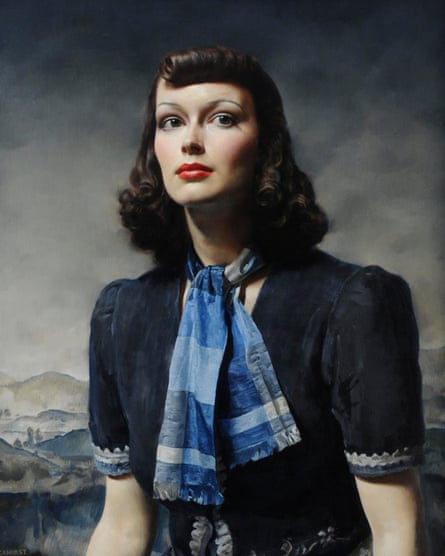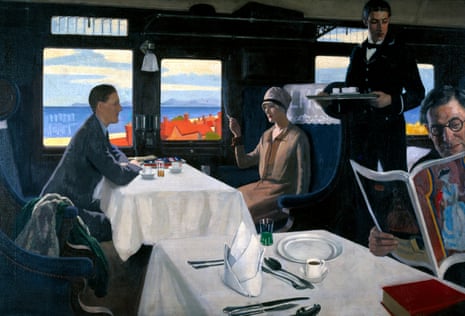This exhibition invites us to look at art that has long been scorned or ignored. British realist painting between the wars is primarily associated with the Royal Academy during that institution’s most retrograde period; when shown in the annual Summer Exhibition, its complete rejection of cubism or any form of fragmentation helped keep at bay modernist influences from the continent. In 1937, the critic and supporter of the avant garde Herbert Read declared realist painting to be “occasionally competent in a technical sense, generally sentimental and always utterly insignificant”.
Yet many of the pictures in this exhibition were hugely popular in their day and fetched huge prices. In 1926 the Cornish artist Dod Procter painted a fish merchant’s daughter, dreaming on her bed in dawn light. The painting, titled Morning, attracted such a pitch of interest that the Daily Mail, in a fit of national fervour, bought it for the Tate Gallery. “Realism,” Wyndham Lewis astutely remarked, “is a fine, manly, practical word that appeals to everyone as safe and satisfactory.”

It is not hard to understand why, in the wake of conflict and far-reaching loss, such pictures, with their emphasis on continuities, had enormous appeal. And in today’s world, Gilbert Spencer’s large scale portrait The Rat Catcher (1922) still charms, its seated figure filling the entire height of the picture and the space subtly bent so that we see the spent matches on the floor at his feet. Much in this show undeniably enthrals owing to the microscopic detail and intense scrutiny of appearances. Meredith Frampton’s portrait of Sir Charles Grant Robertson has a startling clarity of definition. Every detail is given the same evenness of attention, with the result that, like a mirror reflection, the portrait is both fully present yet, at the same time, infinitely remote. It is deliberately emotionless, yet weird and compelling.
This ambitious and timely exhibition does more than pull out the unexpected. It recovers realism’s distinct and relevant voice in a short period of rapid change. And the contribution it makes means we can no longer regard British art during the aftermath of the first world war as dim, dull and lacking in direction. Instead, this “parenthesis”, as David Jones referred to the interwar period, shows evidence of great diversity and imaginative vitality.
Last year saw the revival of Winifred Knights’s richly imaginative work at Dulwich Picture Gallery, while at Pallant House, Chichester, Simon Martin’s exhibition The Mythic Method showed us how far-reaching was the classical revival in Britain during the first half of the 20th century. Another eye-opener has been Alexandra Harris’s book Romantic Moderns, which undid the binary opposition between traditional and modern. And now, to unsettle us further, comes this parade of British realists from the 1920s and 30s, with an impressive catalogue by Patrick Elliott and Sacha Llewellyn.
It is clear that “realism” is an umbrella term, referencing a stance or approach and not a unifying style. Less clear is whether it was as progressive as the organisers would have us believe. It was certainly used to persuade and promote such things as the new leisure activities made possible by the Holidays With Pay Act of 1938, as Harold Williamson’s Picnic (1938) reminds us. Advances in transport had opened up the countryside, creating a new vogue for hiking, as is vividly portrayed in James Walker Tucker’s Hiking (c.1936). Realism also helped serve the railways, after the government in 1923 reorganised more than 100 private companies into four big companies. Shown here is Fortunino Matania’s Blackpool (c.1937), commissioned by the London, Midland and Scottish Railway company for reproduction as a poster to advertise the seaside resort.

Awareness of photography informs many pictures. Its increasing sophistication assisted Lancelot Glasson who specialised in sporting pictures, as well as Harold Williamson’s dramatic presentation of sea, rocks and bather in Spray (1939). And flash photography surely lies behind the glossy Hollywood allure that clings to Gerald Brockhurst’s portrait of the Lady Marguerite Strickland, By the Hills (1939), in which the background is loosely based on that found in Leonardo’s Mona Lisa.
Algernon Newton’s Canal Basin (1932) and Outskirts of Cheltenham (1932) may look photographic but are in fact sourced by memory, imagination and small pencil drawings. Whereas there are moments in this show when the realism is coldly rebarbative, these two pictures capture mood, atmosphere and sentiment, as Newton intended them to do: “It seemed to me that it was not the brick and stucco that I wanted to express, but the ghostly presence of its past fading into the night.”
Nostalgia is a recurrent theme. James Bateman, in Haytime in the Cotswolds (1939), synthesises the characteristics of a Cotswold farm at haytime, shutting his eyes to modernity in order to put on record an eternally pre-juggernaut Britain. Another limitation in this art is the all too obvious straining for effect in the large multi-figure compositions. And although eccentricities abound, the idiosyncrasies are not as sharp as those recently found in the Royal Academy’s exhibition America After the Fall: Painting in the 1930s, Grant Wood having the edge over Meredith Frampton.
True to Life also suggests that realism paid scant attention to city scenes and industrial landscape. And after viewing the full length of Albert Rutherson’s eight-panel screen, with its fey pastoral decorations, Edward Burra’s low-life scene The Snack Bar (1930), with its biting satire and bare lightbulb, came as a welcome shock.

Comments (…)
Sign in or create your Guardian account to join the discussion